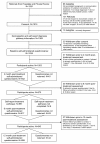Diagnostic and treatment pathways for men with prostate cancer in Queensland: investigating spatial and demographic inequalities
- PMID: 20731875
- PMCID: PMC2936907
- DOI: 10.1186/1471-2407-10-452
Diagnostic and treatment pathways for men with prostate cancer in Queensland: investigating spatial and demographic inequalities
Abstract
Background: Patterns of diagnosis and management for men diagnosed with prostate cancer in Queensland, Australia, have not yet been systematically documented and so assumptions of equity are untested. This longitudinal study investigates the association between prostate cancer diagnostic and treatment outcomes and key area-level characteristics and individual-level demographic, clinical and psychosocial factors.
Methods/design: A total of 1064 men diagnosed with prostate cancer between February 2005 and July 2007 were recruited through hospital-based urology outpatient clinics and private practices in the centres of Brisbane, Townsville and Mackay (82% of those referred). Additional clinical and diagnostic information for all 6609 men diagnosed with prostate cancer in Queensland during the study period was obtained via the population-based Queensland Cancer Registry.Respondent data are collected using telephone and self-administered questionnaires at pre-treatment and at 2 months, 6 months, 12 months, 24 months, 36 months, 48 months and 60 months post-treatment. Assessments include demographics, medical history, patterns of care, disease and treatment characteristics together with outcomes associated with prostate cancer, as well as information about quality of life and psychological adjustment. Complementary detailed treatment information is abstracted from participants' medical records held in hospitals and private treatment facilities and collated with health service utilisation data obtained from Medicare Australia. Information about the characteristics of geographical areas is being obtained from data custodians such as the Australian Bureau of Statistics. Geo-coding and spatial technology will be used to calculate road travel distances from patients' residences to treatment centres. Analyses will be conducted using standard statistical methods along with multilevel regression models including individual and area-level components.
Conclusions: Information about the diagnostic and treatment patterns of men diagnosed with prostate cancer is crucial for rational planning and development of health delivery and supportive care services to ensure equitable access to health services, regardless of geographical location and individual characteristics.This study is a secondary outcome of the randomised controlled trial registered with the Australian New Zealand Clinical Trials Registry (ACTRN12607000233426).
Figures
Similar articles
-
A multilevel investigation of inequalities in clinical and psychosocial outcomes for women after breast cancer.BMC Cancer. 2011 Sep 28;11:415. doi: 10.1186/1471-2407-11-415. BMC Cancer. 2011. PMID: 21951320 Free PMC article.
-
A multilevel study of the determinants of area-level inequalities in colorectal cancer survival.BMC Cancer. 2010 Jan 28;10:24. doi: 10.1186/1471-2407-10-24. BMC Cancer. 2010. PMID: 20109230 Free PMC article.
-
Factors associated with treatment received by men diagnosed with prostate cancer in Queensland, Australia.BJU Int. 2012 Dec;110(11 Pt B):E712-9. doi: 10.1111/j.1464-410X.2012.011533.x. Epub 2012 Sep 27. BJU Int. 2012. PMID: 23017157 Clinical Trial.
-
Appendix to dialysis centre guidelines: recommendations for the relationship between outpatient haemodialysis centres and reference hospitals. Opinions from the Outpatient Dialysis Group. Grupo de Trabajo de Hemodiálisis Extrahospitalaria.Nefrologia. 2011;31(6):664-9. doi: 10.3265/Nefrologia.pre2011.Oct.11001. Nefrologia. 2011. PMID: 22130281 English, Spanish.
-
Geographic disparities in prostate cancer outcomes--review of international patterns.Asian Pac J Cancer Prev. 2015;16(3):1259-75. doi: 10.7314/apjcp.2015.16.3.1259. Asian Pac J Cancer Prev. 2015. PMID: 25735366 Review.
Cited by
-
Association between single-nucleotide polymorphisms in growth factor genes and quality of life in men with prostate cancer and the general population.Qual Life Res. 2015 Sep;24(9):2183-93. doi: 10.1007/s11136-015-0950-6. Epub 2015 Feb 28. Qual Life Res. 2015. PMID: 25724697
-
Education and mammographic breast density.Breast Cancer Res Treat. 2025 Apr;210(2):377-384. doi: 10.1007/s10549-024-07575-5. Epub 2024 Dec 17. Breast Cancer Res Treat. 2025. PMID: 39688757
-
Influence of occupation and education level on breast cancer stage at diagnosis, and treatment options in China: A nationwide, multicenter 10-year epidemiological study.Medicine (Baltimore). 2017 Apr;96(15):e6641. doi: 10.1097/MD.0000000000006641. Medicine (Baltimore). 2017. PMID: 28403116 Free PMC article.
-
Association between Prostinogen (KLK15) genetic variants and prostate cancer risk and aggressiveness in Australia and a meta-analysis of GWAS data.PLoS One. 2011;6(11):e26527. doi: 10.1371/journal.pone.0026527. Epub 2011 Nov 23. PLoS One. 2011. PMID: 22132073 Free PMC article.
-
Genetic association of the KLK4 locus with risk of prostate cancer.PLoS One. 2012;7(9):e44520. doi: 10.1371/journal.pone.0044520. Epub 2012 Sep 6. PLoS One. 2012. PMID: 22970239 Free PMC article.
References
-
- Ferlay J, Bray F, Pisani P, Parkin DM. GLOBOCAN 2002: Cancer incidence, mortality and prevalence worldwide. http://www-dep.iarc.fr/ 23 July 2007.
-
- Australian Institute of Health and Welfare. Australia's health series no. 12. Cat. no. AUS 122. Canberra: AIHW; 2010. Australia's health 2010.
-
- Sakr WA, Haas GP, Cassin BF, Pontes JE, Crissman JD. The frequency of carcinoma and intraepithelial neoplasia of the prostate in young male patients. Journal of Urology. 1993;150:379–385. - PubMed
Publication types
MeSH terms
LinkOut - more resources
Full Text Sources
Medical


